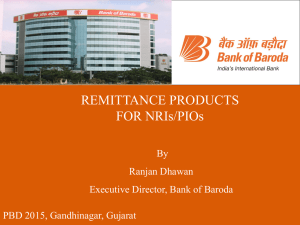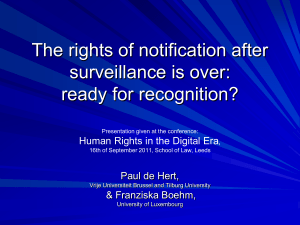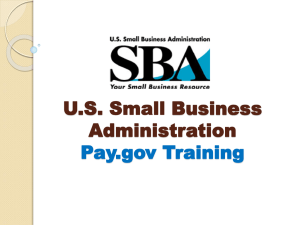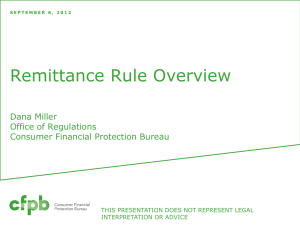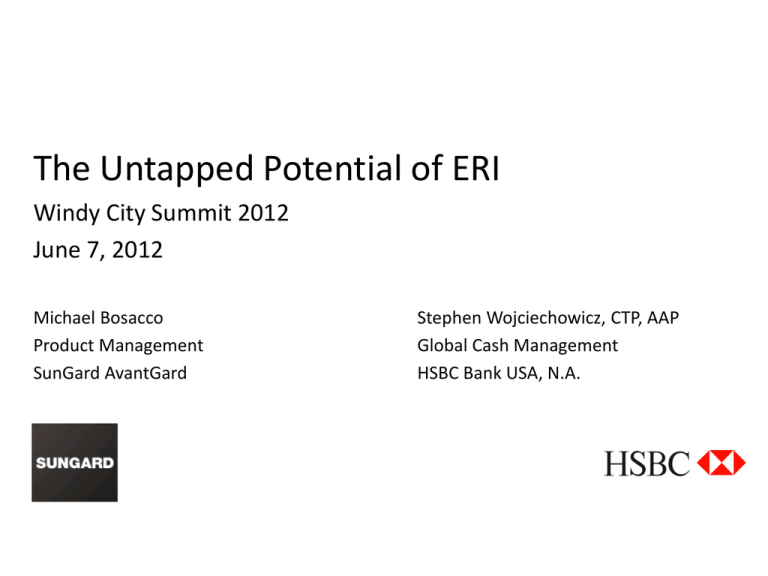
The Untapped Potential of ERI
Windy City Summit 2012
June 7, 2012
Michael Bosacco
Product Management
SunGard AvantGard
Stephen Wojciechowicz, CTP, AAP
Global Cash Management
HSBC Bank USA, N.A.
Background for Format Change
For many years, U.S. corporations have been asking the Fed to change the
wire transfer message format
– In 2005, AFP estimated that 17% of incoming wire transfers require manual
research costing $35 each time
– Numerous surveys of corporations and banks were conducted by the Federal
Reserve Banks, the Clearinghouse, and the AFP in subsequent years
– In 2010, AFP Electronic Payments Survey estimated top barriers to the
adoption of electronic payments
• Inability to send or receive automated remittance information (77 percent) &
• No standard format for remittance information (72 percent)
New Fedwire® and CHIPS® format change announced in 2008
– Implemented in November 2011
What is included in the new format?
Remittance Information
• Up to 9,000 characters of the following types of business remittance
information:
1.
Unstructured
–
2.
Related
–
3.
Block of data formatted according to another standard (e.g.,
EDI, ISO 20022), but not edited by Fedwire.
Used to identify a reference number and the location of
remittance information if exchanged outside of the wire
payment.
Structured
–
Specific “tags” edited by Fedwire and CHIPS to carry invoice
details
Payment Notification
Improved Cover Payments
Benefits of Extended Remittance Information (ERI)
Reduce costs associated with existing wire volume
Opportunity to electronify urgent/high-dollar payments
Inclusion of remittance details in wire payments will expedite
processing/posting
– Improved STP rates
– Originators may receive discount for paying electronically via wire
– Receivers may begin asking trading partners to pay them via wire
– Opportunity to leverage existing AP applications or ERP systems that today
create ACH payments with remittance information in EDI, STP 820, ISO20022
or other formats
ERI – Bringing Wires Up the Curve
Other payment modes in the US provide rich information remittance
options (check / ACH)
Lack of ERI reduces the incentive to make or receive payments through
wires
Clear end-user support for ERI voiced through multiple independent
surveys
Staggered but sustained growth expected
What Makes This a Complex Implementation?
Banks typically utilize different internal systems for processing of wire
payments and processing of information
Multiple clearing channels and multiple customer delivery channels
further complicate pathways necessary
Multiple formats make it difficult to focus development
Local versus international payments
Why This is Not Just a Local Development?
Many wires originated in the US are for cross-border payments
ERI passage to the beneficiary will be a function of international banks
participating in the MT103 REMIT MUG or creation of an industry utility
Definite global movement towards provision of information that aids STP
reconciliation; PMPG taking a lead within banking industry
Corporate Implementation Check-list
Engage banks in a dialogue
Engage internal IT / vendors
Refer to the best practices document published by Federal Reserve
addressing originators, banks and beneficiaries
Domestic Remittance Best Practices Core Philosophies
Originator
Validate that Originator’s
Bank and the Beneficiary
can receive ERI before
sending.
Send to Originator’s Bank
in any mutually agreed
upon format.
Beneficiary’s Bank
Translate from a common
denominator format.
Report to the Beneficiary
in any mutually agreed
upon format.
Originator’s Bank
Translate to a common
denominator format.
• Fedwire CTP
structured remittance
format
• X12 820 format (STP
820 is recommended)
Intermediary Bank
Pass on data to next party
as received.
Beneficiary
Before requesting ERI from
the Originator, validate
that Beneficiary’s Bank can
report in agreed upon
format.
Benefits and their Measurement
To Originators:
• Reduced overhead cost of alternative communication channels for sending
remittance information
• Reduced follow-up calls from vendors seeking clarifications on wire payments
To Beneficiaries:
• Reduced time and cost of reconciling wire payments
• Better and more updated MIS on Days Sales Outstanding
From This…
Remitter: ABC Company
Payment Amount: $5678.99
Transaction Detail:
Detail Type: 188
Availability: S
$5678.99
0.00
00009823638334930
Originator: ABC Company
Account Number: 83423747239
Attention: Accounts Receivable, XYZ Company
PO Box 27273
Anytown MD
Bank: 123 Bank ABA: 001562818
Beneficiary: XYZ Company
Detail:
214 spigots for invoice number 56675434 PO number 1576565
Date: 09122011
Time: 0715 hours
0.00
0.00
To This…
Benefits of Payment Notification
Provides corporate originators the ability to track their payment through
the payment chain and confirm that their payment has been processed.
• Particularly when the payment is high-value, critical, time-sensitive
Popularized by shipping companies
New Payment Notification Field {3620}
Includes optional data elements that banks can use to provide payment
notification services to their clients.
• Contact electronic address (could be e-mail or URL)
• End-to-end identification number
Market practice conventions or bilateral agreements will specify how the
data elements will be used
• First industry-wide use case recently developed
– Originator Model (Payment Notification Indicator = “1”)
• Other models have also been discussed (named for the party being
notified)
– Beneficiary Model
– 3rd Party Model
Payment Notification Guidelines
Product of industry workgroup led by the Fed
Creates the concept of a Payment Notification User Group (PNUG)
Establishes set of market practices surrounding the use of tag {3620} that
PNUG members should follow.
•
Ultimately designed to provide notification to the originator when the funds transfer is
credited to the beneficiary (i.e., the “originator model”)
Fed maintains list of PNUG members on its public website.
Fed requires PNUG members to sign an agreement indicating intent to
follow the Payment Notification Guidelines
•
New Appendix E to Operating Circular 6 available on FRBservices.org.
– Appendix E-1 – for “Participant Members”
– Appendix E-2 – for “Agent Banks” acting as agent for “Non-participant members”
Payment Notification
Fedwire Funds Service
Tag {3620} Payment Notification
Notification Indicator =
1
Notification electronic address= Notify@1stBank.com
Notification reference number = XXXXXXXXXXXXX
Notification e-mail – 2nd Bank must participate for
1st Bank to offer notification
1st Bank
Wire Fee
Notification
Fee
2nd Bank
Notifications
Originator
requests
wire with
notification
Notification E-mail Content
ABA or BIC or UID of party sending the e-mail
Notification reference number
Status code : Accepted Settlement Complete or Rejected
Time Stamp when status was achieved
Beneficiary
Early Adopters
During March 2012:
• About half of Fedwire Funds traffic utilized the new Customer Transfer Plus
(CTP) message (primarily using traditional rather than new fields)
• Usage of new fields on Fedwire Funds:
– 115 institutions sent about 10,000 cover payments per day
– About 300 institutions sent about 9,000 messages per day using the new
originator Option F field
– 15 institutions sent about 110 messages per day using the extended
remittance fields, primarily using the “narrative” code for free text
• Five Fedwire participants joined the Payment Notification User Group
DISCLAIMER
This information was prepared exclusively for the benefit and use at the Windy City Summit on June 7, 2012 and contains information
proprietary and confidential to HSBC Bank USA, N.A. (“HSBC”) and the Federal Reserve Banks. Neither this presentation nor any part thereof
may be used for any other purpose or disclosed to a third party without the prior written consent of HSBC and the Federal Reserve Banks.
The presentation provides an overview of certain relevant activities concerning US dollar wire payments. It is not intended to provide specific
compliance guidance. Attendees should review compliance concerns with their internal legal and compliance counsels.
The information herein reflects our services and activities as of this date and are subject to change. The information herein is not intended as
an offer or solicitation for the purchase or sale of any financial instrument nor to amend or supplement any agreement.
Any information herein obtained from independent sources is believed to be reliable, but HSBC does not warrant its accuracy or completeness.
Please note that regulations and practices change from time to time and the reader is advised to consult HSBC Global Payments and Cash
Management, and confirm with independent legal and tax experts prior to the implementation of any cash management structure.
The products and services described herein are subject to the previous authorization of the corresponding local entity of HSBC Group and to
the terms and conditions of their corresponding agreements. The execution of every agreement is made on a case by case basis according to
the market practice and the applicable local legislation. Therefore, neither this document nor any part hereof is intended as an obligation to
celebrate any contract and its exhibits or annexes are only for information purposes.
United States persons (including entities) are subject to U.S. taxation on their worldwide income and may be subject to tax and other filing
obligations with respect to their U.S. and non-U.S. accounts. U.S. persons and entities should consult a tax adviser for more information.
Issued by HSBC Bank USA, N.A. © 2012 HSBC Bank USA, N.A. ALL RIGHTS RESERVED.

